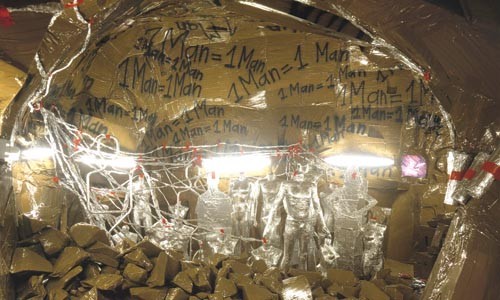Curator Douglas Fogle's title for the 55th Carnegie International, Life on Mars, doesn't suggest a literal search for extraterrestrial life. Rather, it implies a metaphorical exploration of what it means to be human in today's accelerated and insecure world, and of our desire to connect with something, anything, even the unknown.
The anecdote with which Fogle begins his catalogue essay speaks volumes: the Pioneer 10 Spacecraft, sent to photograph Jupiter, relayed its last signal to Earth on Jan. 23, 2003. Yet the engineers who designed the vessel bolted to its underside a metal plaque inscribed with line drawings depicting male and female humans and schematics of our solar system's relationship to the galaxy; the spacecraft thus continues to function as a miniature time machine, or "cave drawing," carrying a modicum of information about our likely insignificant civilization into the vast unknown.
In the same way, each of the artists in the International provokes a grand metaphysical question or suggests another world altogether, often by using the humblest of materials. Perhaps best exemplifying this idea is Paris-based Thomas Hirschhorn's Cavemanman, originally installed in 2002 at Barbara Gladstone Gallery, in New York City. It is a large, walk-through labyrinth of caverns and passageways made of cardboard and packing tape, its invisible skeleton constructed of two-by-fours. It is like entering a modern-day Lascaux cave. In fact, two television monitors "taped" into the walls of the cave screen videos of Lascaux II, which is a replica of Lascaux and its 16,000-year-old cave paintings that was created 200 meters from the original site (which is now closed to the public.) The irony of a "fake" cave presented inside another "fake" cave is not lost.
Hirschhorn's cave seems slightly un-cavelike in that it is brightly lit with fluorescent tubes and has higher-than-expected ceilings. But its most notable elements are the mannequins and cutout figures covered in tin foil. They are arranged in groups throughout, one group in each little warren. The life-sized figures have tin-foil cords projecting from their heads that connect them together and then to "dynamite" made of tape, cardboard and foil, attached to the cave walls. Various books, ranging from works by Nietzsche to Foucault, are attached to the dynamite as well. It is as if the civilization in the "cave," and its knowledge, signified by the books, are seconds from destruction.
Detritus left by imaginary visitors to the cave litters the tape-and-cardboard floors: Soda cans spill out of trash bins and spew from piles of cardboard "rocks." One room within the cave, reminiscent of a college dormitory, contains bookshelves, high on the wall and filled with texts. Pop-culture posters of such notables as Bam Margera, Bob Marley and Amy Winehouse, among others, plaster the ceiling. Meanwhile, the walls of another room are spray-painted in black with the tag "1Man=1Man," a fallacious circular argument: Such arguments can never advance our knowledge, which, according to Hirschhorn, seems destined for destruction at any rate.
In a room close to the entrance of the cave, the walls are papered with photocopied "world clocks" all set to the same time: 10:10 on Saturday the 22nd. Perhaps this signifies that, at the impending apocalyptic meltdown of this civilization of modern cavemen who desperately attempt to attach meaning to their existence through written language and popular culture, the arbitrary differences in time between Marrakech and Boston will no longer matter.
Life on Mars, the 55th Carnegie International, continues through Jan. 11. Carnegie Museum of Art, 4400 Forbes Ave., Oakland 412-622-3131 or www.cmoa.org.















